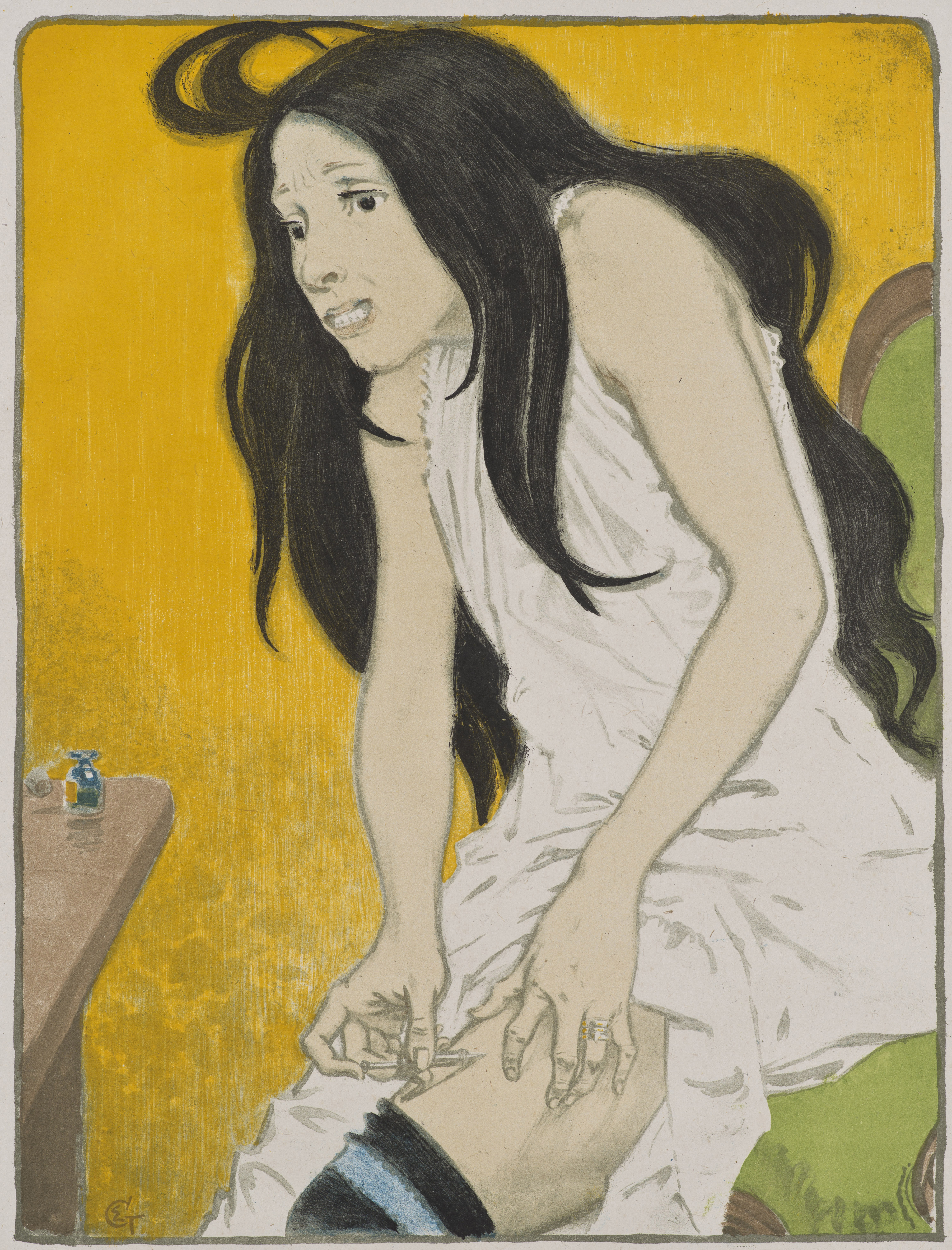Hammer exhibition explores Parisian female archetypes

UCLA’s Hammer Museum’s newest exhibition, “Tea and Morphine: Women in Paris, 1880 to 1914,” comprises of about 100 works that explore Parisian female archetypes, including Eugene Grasset’s “La morphinomane (The Morphine Addict).”
By Jessica McQueen
Jan. 27, 2014 12:00 a.m.
A woman furrows her eyebrows and grits her teeth, bracing herself as she pulls up the hem of her skirt. She injects a syringe into her thigh, and on the table beside her sits the source of her pain and detrimental pleasure: morphine.
She is the subject of French artist Eugene Grasset’s print “La morphinomane (The Morphine Addict)” and illustrates a common stereotype of the Parisian woman plaguing society in the late 19th century. In another of Grasset’s works, “La vitrioleuse (The Acid Thrower),” a frowning, sickly green woman clutches a dish of acid, the fatal liquid splashing as she glares at the viewer.
These often extreme images of women are the subject of the UCLA Hammer Museum’s newest exhibition “Tea and Morphine: Women in Paris, 1880 to 1914.” The exhibition, which is comprised of about 100 works including prints, etchings, books and theater programs by 43 artists, explores Parisian female archetypes ranging from morphine addicts to allegorical figures. It will also be the first large-scale exhibition showcasing the Elisabeth Dean Collection since 1986.
Victoria Dailey, the independent curator who helped to arrange the exhibition, said “La morphinomane” stands out the most to her because of itsbold subject.

“(The work) is so powerful. … It looks like it could have been done yesterday, it’s so modern,” Dailey said. “I think it’s a very shocking, unusual image, not only for that time but also for today.”
Dailey said images like this arose from a response to demands for women’s rights. Although women were denied many rights and opportunities for jobs and education, Dailey said, they were able to become prostitutes. These living conditions depressed women, pushing them to turn to substances to ease their misery.
At the same time, Dailey said upper class women who were bored with their lives of leisure and drinking tea also turned to morphine. These drug-addicted woman became a problem in Parisian society, often spurring negative depictions of women as drug addicts, acid throwers and hysterical villains plaguing a male-dominated society.
Cynthia Burlingham, director of UCLA Grunwald Center for the Graphic Arts and co-curator of the exhibition, said this darker subject matter intrigued artists, mostly painters, who began creating prints. Paintings were more formal since they were often displayed in public areas.
“Prints, on the other hand, were more for private contemplation … on a one-to-one basis,” Burlingham said. “A lot of artists … experimented with prints for different subject matter (that was) a lot more undercurrent (and) under the radar.”
Leslie Cozzi, curatorial associate for the Grunwald Center for the Graphic Arts at the Hammer Museum, said the exhibition, however, does not aim to construct binaries between bad and good women – those associated with morphine and tea, respectively. Instead, the variation in the subjects and types of works on display parallel the range of artists’ motives in a complicated society.
While darker portrayals were common, other artists created more sympathetic images, Cozzi said. Auguste Lepere emphasized women’s hard work in his image of laundresses laboring away, while Edgar Degas depicted painter Mary Cassatt at the Louvre.
Degas’ work represents Cassatt as an individual rather than as one of the female archetypes common during the period.
“(This work shows)an artist depicting someone as a colleague who is also looking at art,” Cozzi said. “She becomes an artwork herself but you don’t get the sense that there’s a lack of respect.”
Cozzi also said the exhibition also reveals links between concurrent artistic movements, including Impressionism and Symbolism. The vivid colors, flat perspective and bold lines in many of these prints, for example, were reappropriated from Japanese prints that inspired many Impressionists.
Though these works are dated to the turn of the 19th century, Dailey said they can still relate to contemporary life and issues like drug addiction and women’s rights that are still prevalent.
“There are many areas of information and knowledge to fill in by looking at the past,” Dailey said. “You get a much better picture of the present by looking at the past, at what has changed and what hasn’t.”


